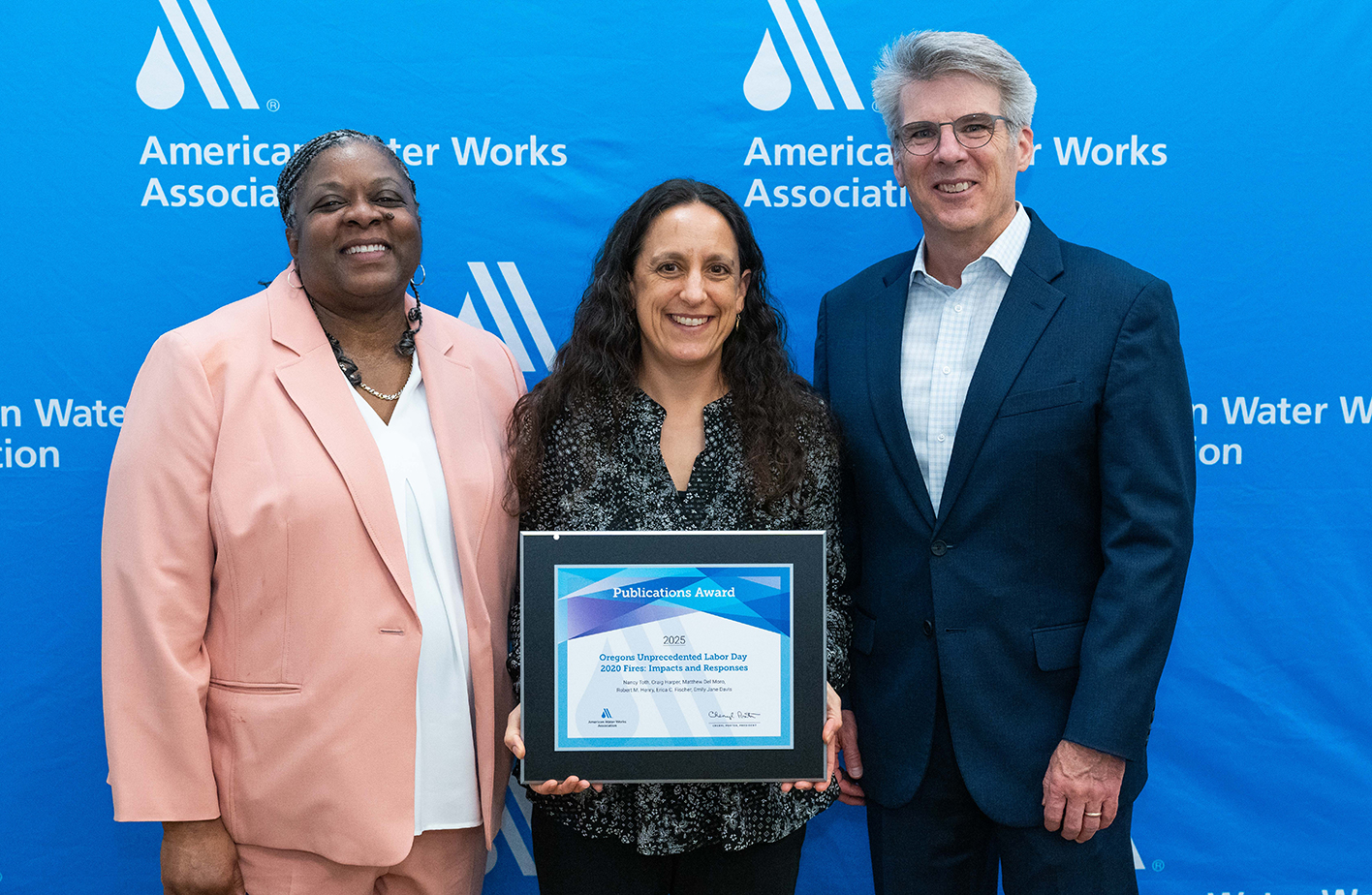Related News
Related News
-
EWEB Sets 2026 Budget and Rates, Advances Evaluation of McKenzie Valley Service Territory Realignment
Taken together, the 2026 budget and rate adjustments and the territory-realignment evaluation reflect EWEB’s dedication to responsible financial stewardship, modern, resilient utility infrastructure, and thoughtful planning for the future.
Find Out More -
Women in STEM: Meet the Hydro Project Engineer Building Habitat for Salmon
EWEB Engineer Associate Val Chang found her way to the McKenzie River from Los Angeles, inspired by heritage trips to the waters of Taiwan and key mentors along the way.
Find Out More -
Public Power Week Poster Contest Winners 2025
The results are in! View the winning posters from EWEB's 2025 Public Power Week Poster Contest.
Find Out More -
EWEB Hometown Heroes compete internationally
Out of 290 teams from 14 different countries, EWEB's Lineman Rodeo team places in the top third of competitors.
Find Out More -
EWEB's Halloween Truck-or-Treat is a huge success
Community members are accustomed to spotting EWEB trucks around Eugene streets and neighborhoods. But last week, those familiar vehicles looked a little different. At EWEB's second annual Truck-or-Treat Customer and Crew Appreciation Event, our fleet transformed into a festive Halloween spectacle.
Find Out More -
Sustainability Snapshot - Celebrating Energy Efficiency Projects in the Community
Sustainability Snapshops highlight impactful projects completed by EWEB's Customer Solutions department, as a way to celebrate the meaningful work happening behind the scenes.
Find Out More -
Let's Talk Turkey. Is your family ready for winter?
We're heading into the holidays, but that also means snow, ice, and not-so-nice weather might be in the forecast. Here are some tips to prepare in advance.
Find Out More -
Vote for your favorite Public Power Week Posters
The top five submittals will receive awards. Help us pick the winners.
Find Out More -
EWEB Hosts Annual Spill Drill to Protect McKenzie River
EWEB led emergency responders in its annual “spill drill” on the McKenzie River on Wednesday, Oct. 15, at the Trail Bridge Campground.
Find Out More -
A day in the life: Monitoring water quality throughout the McKenzie Watershed
Follow Senior Environmental Specialist David Donahue as he collects water quality samples from throughout the watershed as part of EWEB's early warning system for threats to Eugene's drinking water.
Find Out More -
EWEB Partners with Eugene School District 4J to Celebrate New Kennedy Middle School Emergency Water Station Site
Hundreds of attendees practiced filling up water containers at Saturday's demonstration event.
Find Out More -
Electric Projects underway in North & South Eugene
Underground lines and disaster-resilient power poles are part of EWEB’s infrastructure upgrade near Eugene’s largest natural resource area.
Find Out More -
EWEB general manager to retire in 2026
EWEB launches nationwide search for next leader to continue the progress of the last decade and ensure a smooth transition.
Find Out More -
Quartz Creek: Setting the Stage for Floodplain Restoration
The project resets the floodplain along 1.8 miles of a formerly channelized creek to improve water quality, fish habitat and natural disaster resiliency.
Find Out More -
Pure Water Partners: 5 Years of Regeneration
As EWEB and the Pure Water Partners observe the fifth anniversary of the Holiday Farm Fire, we celebrate major milestones in the watershed's recovery and check back in with PWP landowners who still have a lot of work ahead as they continue to rebuild their lives.
Find Out More - Show More
EWEB environmental specialist wins prestigious awards for publication
June 25, 2025 • Adam Spencer, EWEB Communications

EWEB Senior Environmental Specialist Nancy Toth – along with co-authors from other utilities and Oregon State University – won two awards from the American Water Works Association (AWWA) for their article recounting efforts to reduce water quality impacts of the 2020 Labor Day fires in Oregon.
The article, "Oregon's Unprecedented Labor Day 2020 Fires: Impacts and Response," describes the recovery and restoration strategies of three affected communities. Toth’s section outlines how EWEB leveraged partnerships with local landowners and environmental stewardship organizations to contain hazardous materials immediately after the fire and to restore the watershed to help it recover over the long term.
It also details the increased monitoring efforts EWEB implemented to support Water Operators’ efforts at the Hayden Bridge Water Treatment Plant.
The authors won the 2025 Distribution & Plant Operations Division Best Article Award and the 2025 Publications Award at the AWWA Annual Conference & Exposition last week. The only multiple-award winner at the national conference, this publication is an important contribution to source water protection as hotter and more destructive wildfires are a growing threat to drinking water sources and distribution systems.
“The trust we built with both partner organizations and the community was vital for working together in the wake of the disaster,” Toth said. “Thanks to the time and effort we put into developing the collaborative Pure Water Partners Program, we were able to rapidly develop and deploy fire recovery and restoration strategies to mitigate some of the impacts of the Holiday Farm Fire.”
The article itself is an act of collaboration. Toth is the primary author; she coordinated with fellow source water protection professionals who responded to the 2020 Labor Day fires throughout Oregon.
The report also summarizes the responses of Medford Water to the Almeda Fire and South Obenchain Fire, and Detroit’s response to the Lionshead Fire.
Together, these efforts represent the water supplies of more than 350,000 people. Each fire affected source water quality, water treatment, and water storage and distribution systems in unique ways. By combining these lessons learned, Toth hopes to encourage water professionals to build partnerships now – before disasters strike.
“Drinking Water Source Protection is a collaborative endeavor, as most water providers do not own their entire watersheds. It is essential that we partner with local, state, and federal land management agencies, watershed councils, non-profit organizations and community members to ensure our source water is protected,” Toth said. “We are fortunate in the McKenzie Valley to have great working relationships – but they didn’t form overnight. Like any relationship, it takes time and following through with our responsibilities to build trust, and it’s hard to build trust in the midst of a disaster.”
Toth’s article was published in the May 2024 issue of Journal AWWA. Along with serving the Eugene and McKenzie Valley communities for 17 years through her work at EWEB, Toth also serves as a trustee in the Water Resources Sustainability Division of the AWWA and was a past Chair of the AWWA Source Water Protection Committee.
She also helped develop and oversee the Pure Water Partners Program, a collaborative effort formed in 2014 to protect drinking water quality and protect and restore riparian and floodplain habitats in the McKenzie River subbasin. PWP organizations include the McKenzie Watershed Council (MWC), Upper Willamette Soil & Water Conservation District, McKenzie River Trust (MRT), Metropolitan Wastewater Management Commission, The Freshwater Trust, the University of Oregon, and the U.S. Forest Service (Willamette National Forest).
After the fire, EWEB led partners to form a Watershed Recovery Task Force to support restoration and recovery efforts on private, nonindustrial timberland and nonfederal public lands. The task force was integrated into Lane County’s emergency operations incident command structure to protect natural resources, develop and use best management practices, and to coordinate watershed recovery.
As soon as it was safe to enter the burned area, EWEB hired a contractor to stabilize private properties by pulling ash, debris, and other toxic materials away from the banks of the river and installing erosion control measures (such as wattles and silt fences) to prevent hazardous materials from running off into the waterways.
EWEB also focused real-time monitoring efforts from urban areas to burned areas, giving treatment plant operators early warning (4 to 6 hours) that contaminating materials were coming down the river, particularly during the fall rains that are typical of this area.
Treatment plant operators were able to optimize treatment and maintain drinking water quality despite the spikes in metals, nutrients, bacteria, sediment, and other contaminants in the initial rainstorms in November and December. It was fortunate that in fall 2020, the “first-flush” rains, which typically arrive in September and October, did not happen until November, giving responders more time to install erosion control measures on streamside properties.
EWEB's treatment plant operators were able to effectively respond to the increased turbidity and suspended solids, and the treated water met all guidelines set by the U.S. Environmental Protection Agency for safe drinking water.
Nearly five years since the Holiday Farm Fire, EWEB continues to monitor and restore areas that were heavily burned.
Although intense rains continue to produce the highest water quality concerns for EWEB’s water supply, some of the most worrisome water quality impacts to the McKenzie watershed have not occurred. Massive landslides due to destabilized slope conditions from burned soils and dead trees could severely contaminate the watershed and even divert or cut off flows, but so far haven’t happened.
EWEB and partners are working to reduce these threats by restoring floodplain habitats and installing large wood structures with downed trees to fortify heavily burned tributaries. These projects can act as buffers to slow the flow of water, contain contaminants, and let sediments drop out of the water.
EWEB is currently working with the MWC, MRT, and U.S. Forest Service on the Quartz Creek Floodplain Enhancement Project in Finn Rock towards these ends.

